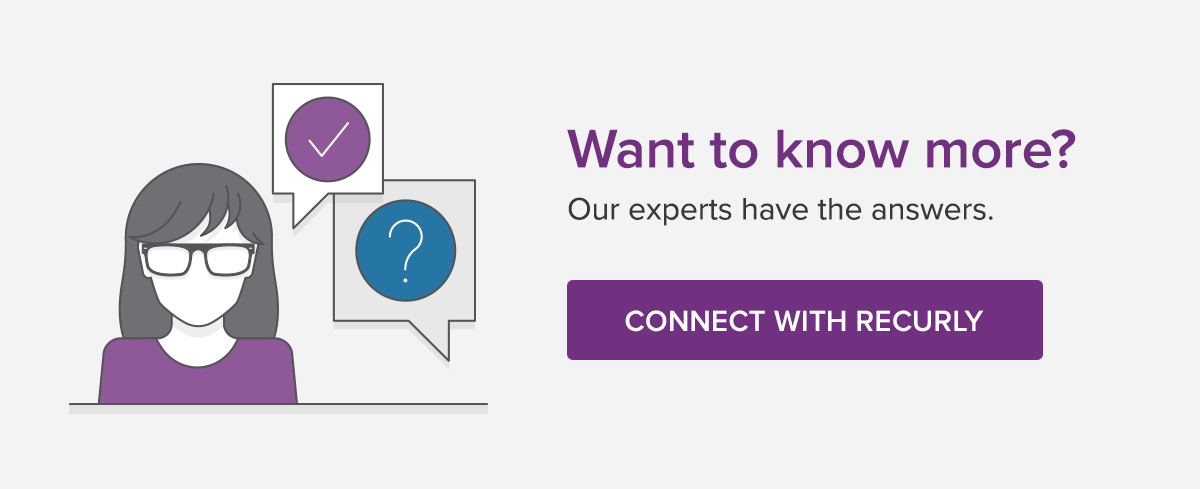How a Dedicated Subscription Billing Platform Can Benefit Finance Teams

As any subscription business knows, recurring billing is complex and presents many challenges that billing for a one-time purchase does not. Different billing models, mid-month upgrades and downgrades, add-on charges, etc. all add to the complexity.
From an accounting and finance standpoint, accurate reporting each month is complicated by these factors, each of which impacts billing and can complicate revenue recognition. And as a business scales, this complexity only increases. Another challenge for finance professionals is that most ERP and CRM systems are not designed to handle recurring revenue.
Reduce the Complexity of Subscription Billing
Subscription commerce is built on the concept of a long-term relationship with the customer. During the course of the relationship, customers may upgrade or downgrade their plans, change plans entirely, add a one-time item, or simply pause the plan temporarily. The business must account for these changes, calculate the charges correctly, and ensure the customer is billed accurately.
In addition to a simple fixed recurring charge, subscription businesses may offer other billing models. Plans may be priced on a per-seat basis, a usage-based schedule, and may have one-time charges or set-up fees. Seat licenses are common with SaaS providers, and these seat charges are commonly prorated if a new seat is added at any point after the beginning of the billing period.
Usage-based charges can be similarly complicated, often involving a fixed monthly charge and additional charges for each customer’s usage. Subscription businesses gain a competitive advantage by offering billing models that best meet their customers' needs and expectations—but that advantage is dependent on the ability to bill correctly for these different scenarios.
Challenges can result too from the recurring nature of payments, especially when credit cards are used. Over the duration of a subscription, a customer’s credit card information can change, the card can be lost or stolen, or the customer may have reached their credit limit. All of these things can cause issues with the payment.
An effective subscription billing solution must be smart and flexible enough to accommodate all these different events. It should have automated means for addressing payment declines to minimize lost revenue. It should also be integrated with popular financial systems so that customer and subscription information is appropriately synced, helping to improve the accuracy of financial reports.
Automated Tools to Eliminate Manual Tasks
Subscription-based enterprises are likely to have customers across the US and possibly around the world, and they must ensure they’re calculating tax correctly based on each customer’s jurisdiction. Taxation is complicated, with different rules for different types of services and for when the tax is levied. Having a tax solution integrated with your subscription billing platform makes compliance much less time-consuming and onerous. As well, taxes on digital services are increasingly common, both in the United States and abroad, further necessitating an automated tax solution to ensure compliance.
Having an automated revenue recognition solution eliminates the need for manual calculations which can be resource-intensive and error-prone. This will prove increasingly valuable as your business grows and will give your staff more time to work on strategic initiatives rather than getting bogged down in complex calculations undertaken within spreadsheets.
Use Data-Driven Insights to Manage Churn
Churn is an important aspect that subscription businesses need to monitor and minimize. Churn can be voluntary or involuntary, and understanding the reasons for both kinds is one key to healthy, sustained growth.
Involuntary churn generally stems from payment declines, and there are a number of ways to address these errors. An effective, sophisticated subscription billing solution will have robust, automated tools to help ensure successful payments. If you can resolve the error before the payment fails completely, you will significantly mitigate involuntary churn and “recover” revenue that would otherwise have been lost. This can make a significant difference to your bottom line. By using automated tools to recover revenue, you also gain by not having to disturb or inconvenience your customers in order to address the payment failure.
While churn is a key metric for subscription commerce, there are other important data points to understand. Accurate analytics will help you to discern the factors driving your business—why subscribers churn, for example, or what plans are the most popular and the most profitable. Robust, easy to understand, readily accessible, and accurate analytics are what enables you to continually optimize your subscription business. Make sure that any subscription billing platform you choose provides the data and insights you need.
To learn more about how accurate, easy to access analytics can help enable subscription growth and profits, read our data sheet.
Dedicated Tools Provide Measurable Benefits
Recurly understands how complicated finance operations can be. And despite being responsible for a variety of critical reporting and forecasting work, finance teams tend to run very “lean.” Tools that can automate key deliverables provide increased accuracy and efficiency. And they allow finance professionals more time and energy to work on strategic initiatives that can impact the company’s bottom line.
Invest in a Dedicated Solution
Without question, subscription businesses benefit from investing in a billing platform designed to handle the inherent complexity of recurring revenue, with tools and features designed specifically for subscription commerce. The best solutions will also be able to scale as the business grows, be flexible enough to support the business as the market and consumer preferences evolve, and be highly secure.
To learn more about how Recurly’s automated tools support Finance teams, visit our website.


